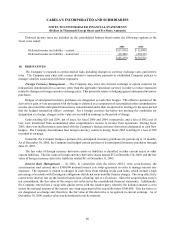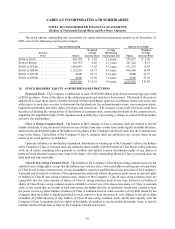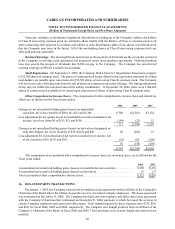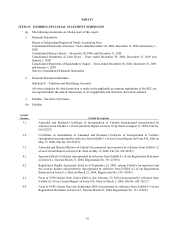Cabela's 2006 Annual Report Download - page 93
Download and view the complete annual report
Please find page 93 of the 2006 Cabela's annual report below. You can navigate through the pages in the report by either clicking on the pages listed below, or by using the keyword search tool below to find specific information within the annual report.
89
CABELA’S INCORPORATED AND SUBSIDIARIES
NOTES TO CONSOLIDATED FINANCIAL STATEMENTS
(Dollars in Thousands Except Share and Per Share Amounts)
17. SEGMENT REPORTING
The Company has four reportable segments: Direct, Retail, Financial Services and Corporate Overhead and
Other. The Direct segment sells products through direct-mail catalogs and its e-commerce websites (Cabelas.com
and complementary websites); the Retail segment sells products through destination retail stores of various sizes
and formats; and the Financial Services segment issues co-branded credit cards. Corporate Overhead and Other
is the Company’s fourth segment primarily made up of land sales, employee discounts, corporate overhead and
shared services. The Company’s executive management, being its chief operating decision makers, assesses the
performance of each operating segment based on an operating income measure. This measure is net revenue less
merchandise acquisition costs and certain directly identifiable and allocable operating costs as described below. For
the Direct segment, these operating costs primarily consist of catalog costs, e-commerce advertising costs and order
processing costs. For the Retail segment, these operating costs primarily consist of labor, advertising, depreciation
and occupancy costs of destination retail stores. For the Financial Services segment, operating costs primarily consist
of advertising and promotion, marketing fees, third party services for processing credit card transactions, salaries and
other general and administrative costs. Corporate and other expenses consist of unallocated shared-service costs,
general and administrative expenses, operations of various ancillary subsidiaries such as real estate development,
travel and lodging (which are not aggregated with the other segments) and eliminations. Unallocated shared-service
costs include receiving, distribution and storage costs of inventory, merchandising and quality assurance costs, as
well as corporate headquarters occupancy costs. General and administrative expenses include costs associated with
general corporate management and shared departmental services such as management information systems, finance,
human resources and legal.
Segment assets are those directly used in or clearly allocable to an operating segment’s operations. For the
Direct segment, these assets primarily include prepaid catalog costs, fixed assets and goodwill. Goodwill made
up $969 of assets in the Direct Segment as of December 30, 2006. For the Retail segment, assets primarily include
inventory in the retail stores, land, buildings, fixtures and leasehold improvements. For the Financial Services
segment, assets primarily include cash, credit card loans, buildings and fixtures. Corporate and other assets include
corporate headquarters, merchandise distribution inventory, shared technology infrastructure as well as corporate
cash and cash equivalents, economic development bonds, prepaid expenses and other assets. In addition to the
capital expenditures presented in the following tables, the Company had unpaid purchases of property and equipment
that are included in accounts payable at fiscal years ended 2006 and 2005. At December 30, 2006 and December
31, 2005, respectively, these amounts totaled $1,572 and $24 for Direct, $12,111 and $5,010 for Retail, $50 and none
for Financial Services, and $6,119 and $3,464 for Corporate Overhead and Other. Depreciation, amortization and
capital expenditures of each segment are allocated to each respective segment. Unallocated assets include corporate
cash and cash equivalents, merchandise distribution inventory for the Retail or Direct segments, the net book value
of corporate facilities and related information systems, deferred income taxes and other corporate long-lived assets.
The accounting policies of the segments, where applicable, are the same as those described in the summary of
significant accounting policies in the Company’s notes to consolidated financial statements. Intercompany revenue
between segments has been eliminated in consolidation.
























